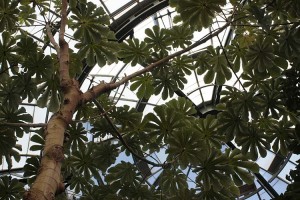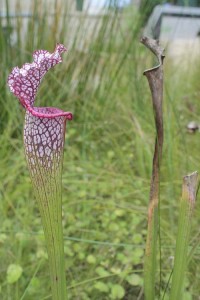I loved this banner at the Huntington. Hanging outside the instution’s conservatory building, it announces that the exhibits inside might be more oriented towards education than the gardens that make up the rest of the grounds. The conservatory also houses plants that might have special needs beyond the “just add water” plantings located in the subtropics outdoors.
Pass through the front doors and you step into a greenhouse space containing a miniature tropical rainforest, a cloud forest and a bog garden, along with lots of educational signs and interactive exhibits scattered throughout the space.
For me most greenhouses and conservatory gardens suffer from being examples of nature-in-a-can, and to me they tend to look and smell and feel very similar in their hermetically sealed spaces. If only the Huntington were located on some barren snowy tundra plain, where entering a tropical rainforest on a cold winter day might be a stunning revelation.
Even on this cool December Southern California afternoon, the temperature differences between inside and out weren’t that pronounced. And the lush plantings outside the front door seemed to mirror the lushly planted indoors. Still, lacking the stunning contrasts that might help to set the conservatory apart from the outdoors, it was a fun place to connect with a lot of cool plants. When the Huntington’s giant corpse-flower (Amorphophallus titanum) blooms, there is where you’ll find it. It wasn’t blooming, but there were lots of other interesting things inside.
The bright red-orange trunks of the sealing-wax palm, Cyrtosstachys renda were pretty amazing.
My visit was two days before Christmas, so there were this holiday display of poinsettias and amaryllis. At first they seemed like gratuitous holiday decorations but then the aha moment struck me that these plants originate in the tropical and subtropical belt of the Americas.
Floral parts of a large anthurium species…
This carnivorous Asian pitcher plant (a species of Nepenthes) greeted visitors as they entered the cloud forest display.
And dropping down into the bog garden, American pitcher plants, Sarracenia, and sundews, Drosera sp., let viewers see other ways plants have taken up carnivorous ways. (Do you detect a theme of the conservatory playing up the idea of scary, creepy plants, going from these carnivorous species to the stinking giant corpse flower that lines up visitors by the hundreds when it does its thing?)
At this point the blogger rambles on a bit: These days it almost seems that every botanical collection feels to have its very own giant corpse flower plant that will draw the visitors when it blooms, something of the way medieval churches tried to draw pilgrims by having unique relics of saints, or how many temples in Asia will claim to have preserved hairs of the Buddha. So it seems that the giant corpse flowers has become a modern secular botanical relic. It’s a little odd, since you can occasionally find the plant for sale on eBay–granted for a good chunk of change–but still nothing much more than you’d pay for a pair of high-end jeans.
Okay, now back to the trip…
I’m coming to the realization that greenhouses always scare me a bit, like I’m entering a world that’s on perpetual life support. Upon leaving the conservatory I stepped outside into the bright December afternoon. Not far away a reader was seated in warming sunlight on a Lutyens bench, enjoying the moment. I’d had a good time on my visit to the synthetic tropics, but returning to the real sunshine and real weather outdoors I suddenly felt free.









